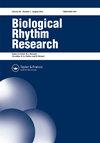Late chronotypes show lower scores on a combined measure of emotional wellbeing: a study in the general population in Greece
IF 0.9
4区 生物学
Q3 BIOLOGY
引用次数: 0
Abstract
ABSTRACTChronotypes describe morningness/eveningness preference Society is morning-oriented and late chronotypes suffer and function in hours that are different from their innate preference (social jetlag). Data suggest links between chronotypes and psychological wellbeing, but relationships are unclear. We explore this relationship using a combined measure representing different domains of psychological wellbeing. Participants (177 adults) were reached through social media and asked to answer questionnaires including demographic and health information; morningness/eveningness (MEQ); State-Trait Anxiety Inventory Y-1 (STAI-Y1); Center for Epidemiologic Studies Depression Scale (CES-D); Risk Assessment Suicidality Scale (RASS); and Quality of Life Uniscale (QoL). Data were transformed using Z-Scores and summed to generate a “Psychological wellbeing” variable. Three variables survived the regression model as contributors to wellbeing: chronotype, general health and past mental health issues. Chronotypes therefore have a significant effect on psychological wellbeing and as a society we may want to take action to assist late chronotypes overcome their challenge.KEYWORDS: Circadian rhythmsquality of lifeemotionalitydepressionanxiety Disclosure statementNo potential conflict of interest was reported by the author(s).一项针对希腊普通人群的研究显示,晚睡的人在情绪健康的综合衡量指标上得分较低
社会以早晨为导向,而晚睡型的人在不同于他们的先天偏好(社会时差)的时间内受苦和活动。数据表明,睡眠类型和心理健康之间存在联系,但关系尚不清楚。我们使用代表心理健康不同领域的综合测量来探索这种关系。通过社交媒体联系参与者(177名成年人),并要求他们回答包括人口统计和健康信息在内的问卷;定做/类型(毫克当量);状态-特质焦虑量表(STAI-Y1);流行病学研究中心抑郁量表(CES-D);自杀风险评估量表;生活质量(QoL)。使用Z-Scores对数据进行转换,并将其求和以生成“心理健康”变量。在回归模型中,有三个变量对幸福感有影响:睡眠类型、总体健康状况和过去的心理健康问题。因此,时间类型对心理健康有重大影响,作为一个社会,我们可能希望采取行动帮助时间类型晚的人克服他们的挑战。关键词:昼夜节律、生活质量、情绪、抑郁、焦虑披露声明作者未报告潜在的利益冲突。
本文章由计算机程序翻译,如有差异,请以英文原文为准。
求助全文
约1分钟内获得全文
求助全文
来源期刊

Biological Rhythm Research
生物-生理学
CiteScore
3.00
自引率
9.10%
发文量
34
审稿时长
6-12 weeks
期刊介绍:
The principal aim of Biological Rhythm Research is to cover any aspect of research into the broad topic of biological rhythms. The area covered can range from studies at the genetic or molecular level to those of behavioural or clinical topics. It can also include ultradian, circadian, infradian or annual rhythms. In this way, the Editorial Board tries to stimulate interdisciplinary rhythm research. Such an aim reflects not only the similarity of the methods used in different fields of chronobiology, but also the fact that many influences that exert controlling or masking effects are common. Amongst the controlling factors, attention is paid to the effects of climate change on living organisms. So, papers dealing with biometeorological aspects can also be submitted.
The Journal publishes original scientific research papers, review papers, short notes on research in progress, book reviews and summaries of activities, symposia and congresses of national and international organizations dealing with rhythmic phenomena.
 求助内容:
求助内容: 应助结果提醒方式:
应助结果提醒方式:


